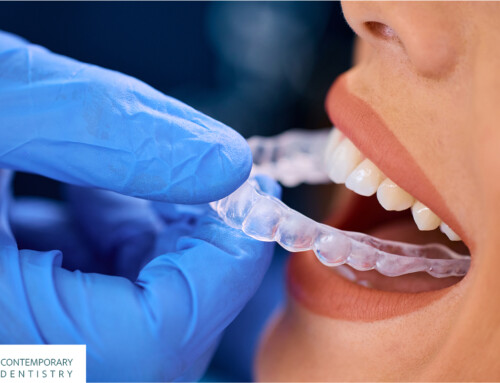Are you considering orthodontic treatment but wondering about the timeline? One of the most common questions we hear at Contemporary Dentistry is: “Is Invisalign® faster than braces?” It’s a great question, and the answer involves understanding several factors that influence your treatment journey toward that perfect smile.

Invisalign® vs Traditional Braces
When it comes to achieving a straighter smile, time is often a significant consideration. Many patients are drawn to Invisalign® because of its reputation for potentially faster results compared to traditional metal braces. But is this reputation deserved?
In mild to moderate cases, yes—Invisalign® treatment can work more quickly than traditional braces. The innovative technology behind these custom-made aligners often allows for more efficient tooth movement in moderate cases. While traditional metal braces typically require 18-24 months of treatment, Invisalign® can sometimes achieve similar results in less time, with many patients completing treatment in 12-18 months.
However, the speed of treatment depends greatly on various factors specific to your situation. Let’s explore what influences your orthodontic timeline.
What Affects Your Treatment Time Frame?
The complexity of the case is perhaps the most significant factor determining whether Invisalign® will be faster than braces for your specific needs.
For mild to moderate orthodontic problems like slightly crooked teeth or minor spacing issues, Invisalign® aligners often provide quicker results than traditional braces. The custom-fit technology by Align Technology allows for precise, controlled movement that can efficiently shift teeth into the correct position.
However, for severe misalignment, complex bite issues, or significant dental issues requiring extensive tooth movement, traditional braces might actually work more efficiently. Metal wires and brackets provide the orthodontist with more mechanical control to move teeth in complex cases.
Patient Compliance is A Critical Factor
One often overlooked aspect when comparing the two teeth-straightening options is the role you play in your treatment timeline. Invisalign® offers the convenience of removable aligners—but therein lies both an advantage and a potential pitfall.
For Invisalign® to work properly and deliver faster results, you must wear your aligners for 20-22 hours daily. Removing them only for eating, drinking anything besides water, and oral hygiene routines is essential. Patients who don’t follow this protocol may extend their treatment period significantly.
With traditional metal braces, compliance is less of an issue since they’re fixed appliances. However, maintaining excellent dental hygiene around brackets and wires becomes more challenging, potentially leading to other dental appointments for related issues.

How Does Invisalign® Work?
Invisalign® employs a series of custom-made aligners designed specifically for your patient’s teeth. Each set of clear aligners applies gentle pressure to gradually move teeth into the desired position. Typically, you’ll switch to a new set of Invisalign® trays every 1-2 weeks, with each set bringing your teeth closer to their perfect alignment.
The technology behind Invisalign® allows your dentist to:
- Create a detailed treatment plan using advanced 3D imaging
- Predict tooth movement with remarkable accuracy
- Make adjustments throughout the treatment as needed
- Potentially achieve faster results for suitable cases
Related Article: How Long Does Invisalign® Take If You’ve Already Had Braces?
Traditional Braces are Still a Powerful Option
While Invisalign® has become an incredibly popular choice, traditional braces remain highly effective and sometimes the best option for certain orthodontic problems. Modern metal braces are more comfortable and less noticeable than those of previous generations.
Traditional metal braces excel at:
- Treating severe misalignment issues
- Addressing complicated bite problems
- Managing complex tooth movements
- Handling cases where patient compliance might be a concern (particularly with younger patients)
There are also variations like ceramic braces or lingual braces that offer aesthetically pleasing alternatives while providing the mechanical advantages of conventional fixed appliances.
Other Factors in the Invisalign® vs Braces Decision
While treatment time is important, making an informed decision requires considering several other factors:
Appearance
Invisalign® provides nearly invisible aligners that many patients prefer for aesthetic reasons over metal braces. For those concerned about their appearance during treatment, this can be a deciding factor regardless of whether treatment takes slightly longer.
Comfort
Many patients report that Invisalign® feels more comfortable than traditional braces, which can cause irritation from brackets and wires. This improved comfort might make a slightly longer treatment period more tolerable.
Convenience
The ability to remove Invisalign® trays for eating and dental hygiene makes maintaining oral health significantly easier compared to navigating around fixed metal braces.
Cost Considerations
The cost of Invisalign® treatment versus traditional braces may vary, though they’re often comparable. Your dental insurance coverage might influence this aspect of your decision.
The Perfect Smile Takes Time
At Contemporary Dentistry, we understand that each patient’s orthodontic journey is unique. Whether Invisalign® provides faster results or traditional braces offer a better solution for your specific needs depends entirely on your patient’s teeth and treatment goals.
Both options have their place in modern orthodontics, and the best choice balances treatment speed with the quality of results. Remember that investing in proper tooth alignment contributes to both aesthetic appeal and long-term oral health.





